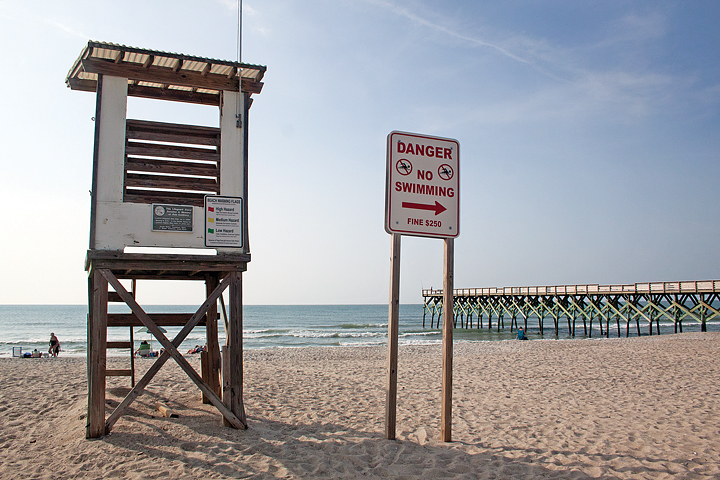Rip currents account for 80 percent of ocean rescues in Wrightsville Beach, said Wrightsville Beach Ocean Rescue Capt. Jeremy Owens.
“Second to that would be swimmer ability and/or a combination of the two,” he said.
“If you look at drowning statistics about one-third of the actual drowning victims are rescuers,” said coastal construction and erosion specialist Spencer Rogers of North Carolina Sea Grant. “We think what is happening is a poor swimmer gets in trouble, some unskilled rescuer — not a lifeguard — goes out and attempts to make a rescue and overexerts himself. But the victim makes it back in many of these cases.”
Even though National Rip Current Awareness Week has come and gone, Wrightsville Beach is one of the most documented by the National Weather Service among all U.S. beaches for rip current presence, Rogers said.
“They’re second in the country in rip current reports, and the only one beating them is San Diego County,” Rogers said.
Those reports have been compiled during the last seven years from twice daily updates from WBOR, Owens said, one at 10 a.m. and a second at 3 p.m. While WBOR updates the NWS by phone it signals its rip current forecast to the beach-going public by way of a flag system, not unlike the universal traffic light system.
“Look at the flags . . . and speak with the lifeguards,” Owens said.
The green, yellow and red flag system indicates green for calm conditions, yellow for swim-with-caution warnings along with the presence of some rip current activity, and red for danger, or hazardous conditions, strong rip currents and wave action present.
The lifeguards, Owens said, are on duty to point out rip currents, help beachgoers identify what they look like and advise what to do when caught in one while swimming.
“A rip is a channel of churning, choppy water,” he said. Visual clues include a difference in water color caused by sediment trapped in a watery trough located between the littoral — where the ocean meets the sand — and the sand bar. The rip current appears to be a muddy river or perpendicular line of foam or debris moving seaward.
Though rip currents are present at any time, they are typically strongest two hours on either side of low tide, Owens said.
“You have incoming surf, incoming waves, spill over into the trough,” he explained. “All this water is in front of the trough and it needs to get back out. . . . It’s going to take the path of least resistance and that’s the reason — that break in the sandbar — all that water is going to rush back out to sea.”
Owens said the width of the rip current is fairly narrow, about 20-50 yards wide. Rogers shrunk the distance to 20-50 feet. Swimmers caught in rip currents are advised to remain calm, and swim parallel to the shoreline until they are out of the rip current’s path, and when free, swim on an angle toward shore.
Yet, Rogers said, “There are circulation cells that don’t follow the classic image of this jet of water going way out into the ocean.”
Building on evidence collected from West Coast studies, Rogers documented the presence of these circulation cells on East Coast beaches, specifically North Carolina beaches, in 2014.
The West Coast models offered a fairly high percentage of recirculation, he explained.
“Rather than going straight out into the ocean, it actually curls back over the sand bar and gets back to shallow water,” Rogers said. If East Coast circulation cells were measurable with some degree of regularity, it might alter rip current education, “because you have the potential, if you’re in one, that all you have to do is float for five or 10 minutes and you will get back to standing water on top of the bar.”
But the data is not yet sufficient to alter the warning materials for rip current awareness. Those materials target the swimmer as well as the first responder.
“Wave and yell and shout for help from the lifeguard during the day,” Owens said. “Talk to the person if you can. Tell them how to escape, or get them flotation. If it’s a surfer out there that has a surf board . . . just hand the board to the person or a body board but . . . the first thing they need to do if a lifeguard’s not present is call 911.”
This is No. 1 in a series about rip current awareness, research and statistics
email [email protected]




